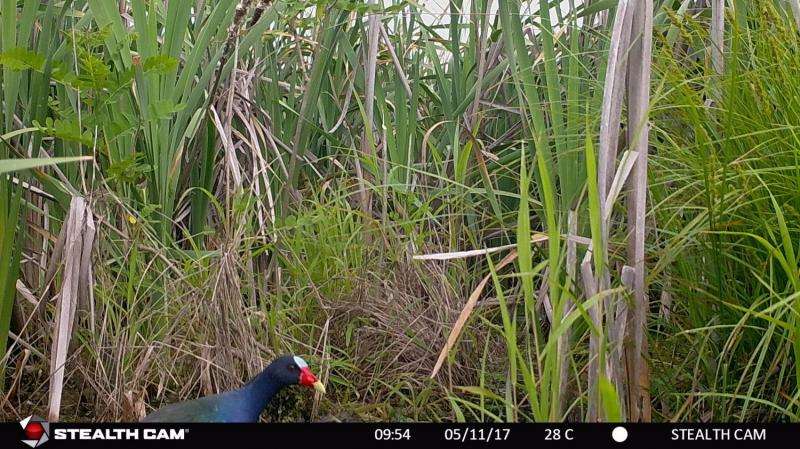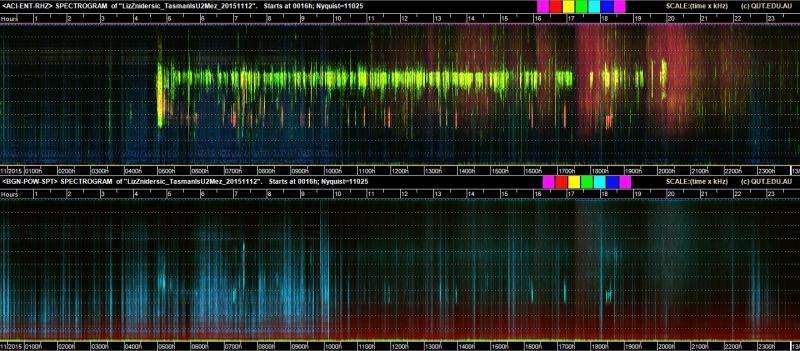Purple gallinule sighted for first time on Oak Ridge Reservation

It is a bright, hot morning in mid-May on the Oak Ridge Reservation. A wildlife camera trap is hidden in the tall grass, passively waiting for a passerby, when a thin, exotic-looking bird walks into the frame.
It is covered in a patchwork of bright colors, with rich purple-blue feathers blending into an iridescent green on its back, a distinctive pale blue spot on its forehead and a bright red beak tipped in yellow. The camera snaps a picture and there it is: The first ever confirmed sighting of a purple gallinule on the Oak Ridge Reservation.
"Finding a previously undetected bird species is a big deal," said Liz Znidersic. "Oak Ridge Reservation has an impressive long-term dataset of bird populations starting in the 1950s, so we are all excited about this find."
Znidersic is a doctoral candidate at the Institute for Land, Water and Society at Charles Sturt University in New South Wales, Australia, where she investigates how a combination of methodologies may assist in the detection of cryptic birds, especially those in the rail family.
Znidersic spent more than five weeks in May and June surveying the Department of Energy's Oak Ridge Reservation with Kelly Roy, wildlife management coordinator for the reservation. Roy met Znidersic at a water bird conference last year and was impressed with her research, so he invited her to Oak Ridge National Laboratory to study local bird populations on the reservation and forge an intercontinental collaboration.
"It has provided the perfect foundation for us to learn from each other, with me bringing experience from multiple wetland systems and Kelly bringing his extensive knowledge of the Oak Ridge Reservation to the table," Znidersic said. "That kind of experience is hard to find and worth its weight in gold."
Znidersic came to Oak Ridge to see if her novel detection methodologies could add any new information to an already extensive species list. After her first survey deployment, she and the Oak Ridge team were surprised by the unexpected appearance of a purple gallinule.
"Though no one has ever personally witnessed this bird on the reservation, we now have documented proof of its existence," Roy said. "I'm very keen to keep track of all vertebrate species on the Oak Ridge Reservation, and this is now the 232nd bird species documented here since 1950."
The purple gallinule is one of the larger and more conspicuous birds in the rail family and is primarily found in South and Central America, the Caribbean and the marshes and coastal areas of Florida and South Carolina. It likes wet, swampy habitats full of dense vegetation to protect it from predators. Though they are capable of flight, they are ground-nesting birds and prefer to get around by running on their spindly yellow legs.
While purple gallinules are more common in West Tennessee, there have been isolated sightings in the east over the past few decades, though none in Roane County.
"There are probably no more than four or five records of purple gallinule in East Tennessee since 2000," Roy said. "We have recorded common gallinule, a different species, several times on the reservation, but this was a first for us and it's all because of Liz coming here."
Znidersic's unique combination of survey methodologies bypasses the hassles of traditional surveying and was critical to the discovery of the purple gallinule.

"It takes a lot of effort to thoroughly survey an area and even more so if you want to find a cryptic bird," Znidersic said. "Finding a purple gallinule at the Oak Ridge Reservation is like finding a needle in a haystack. What we're doing is finding a better way to find the needle."
Znidersic uses a combination of acoustic monitoring and camera traps to record audio and still images around the clock for more than a week at a time. With multiple recording stations scattered around a field site, she forms an invisible wildlife surveillance network capable of efficiently and noninvasively detecting secretive birds.
"When you have more than one unit, you're amplifying your effort in the field," she said. "Instead of making multiple short trips to a site, what we're doing is finding methods that extend our survey time without physically being in the field."
There are many reasons that purple gallinule may be in Tennessee, Znidersic said. It is a notorious wanderer, sometimes straying as far north as Canada. Alternatively, it may have been pushed inland by habitat pressures and competition for resources in coastal areas. Many researchers are currently working hard to understand how changes in the environment and volatile weather patterns are affecting marsh birds.
Znidersic should be able to determine if the individual captured in the photo is part of a breeding population by analyzing the audio recordings from the site. Her collaborators from the Queensland University of Technology Ecoacoustics Research Group transform the audio data into False Color Index Spectrograms, creating cutting edge 24-hour pictures of the sound. Znidersic then interprets the images, investigating multiple species vocalizing in a specific area and identifying vocalization patterns of virtually unknown rail species.
"Through this combination of methods, we have a better chance of knowing they are there or confidently inferring the absence of the species," she said. "This will enable future researchers to identify and monitor changes in the population.
"If we want to protect secretive species, we need to know if they are present, then study their movements and habitat requirements. Land managers can then make informed decisions to assist in their conservation."
Provided by Oak Ridge National Laboratory



















